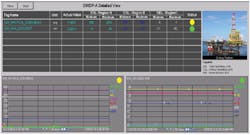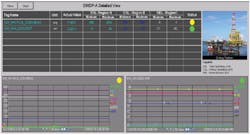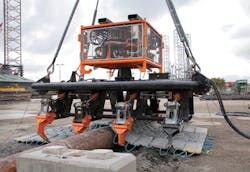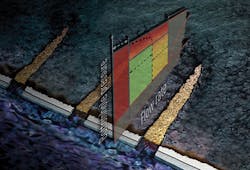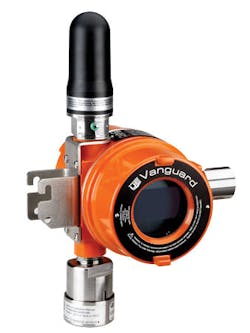New tools and technology for the offshore industry
Data automation speeds up trouble-shooting on Petronas platforms
Petronas Carigali is responsible for 190 offshore platforms and total production of more than 2 MMb/d of oil. Earlier this decade, however, the company was looking to improve offshore data management.
Each of the company’s platforms had its own unique local database for on-site processes, and as a result, operational data was stored across many systems. Platform operators found they were unable to access the real-time data they needed to actively monitor when the operations were at risk of exceeding safe or critical operating limits.
Furthermore, the company was unable to quickly troubleshoot problems when they occurred. Its onshore engineering team was performing data synthesis and analysis: if an issue arose offshore, engineers had to travel to the platform via helicopter, stay overnight, and download the data onto a USB stick to carry it back to regional offices for review and analysis. It could take up to three weeks for engineers to retrieve the data, analyze it, and recommend corrective action. Further time was taken up in implementation, report performance and collecting the data to report results to management in Kuala Lumpur.
The process was extremely time-consuming, according to Musreen Azwan, instrumentation engineer at Petronas, “but we had no other way, because we had to get the data back to the office.” The situation was having a negative financial impact: on one platform, for example, a pressure monitoring system was regularly triggering platform shutdowns when pressure levels surpassed a certain limit. Restoring a platform to normal service after an automated shutdown was typically taking two to three days, resulting in millions of dollars in operating losses. To speed up problem-solving, the company needed more reliable access to its real-time data and therefore turned to OSIsoft’s open enterprise infrastructure PI System. By 2013, Petronas had installed PI servers at eight of its 52 mother platforms in Malaysia, and planned to install the PI System at 38 additional platforms over the following two years.
According to OSIsoft, the PI System accesses historical data and consolidates it with current real-time data to help the user better recurring issues, troubleshoot equipment failures, and compare current versus past production. Intuitive calculation tools provide the user with views of real-time process data within the context of batch processes or key events, and facilitate analysis on the go from tablets, phones, or laptops.
In Petronas’ case, the PI System accesses decades’ worth of important historical data and consolidates it with current real-time data. In an instant, you’re able to uncover information that was tedious or impossible to access before. And you’re empowered to investigate intermittent issues, troubleshoot equipment failures, compare current vs. past production performance and measure new-plant startups against existing facilities.
In addition, sophisticated, intuitive calculation tools enable:
An open, scalable architecture and more than 450 off-the-shelf proprietary interfaces give the PI System its unique ability to collect high-fidelity time-series data from a diversity of sources - agnostic to system, standard, language, frequency, delivery speed, format or device.
Designed to store millions of data points, the PI System centralizes both time-series and event-based data in real time. Information silos merge, system incompatibilities are eliminated, and all data sources become unified. What remains is a responsive, fully integrated information infrastructure that presents one version of the truth to all users and provides incisive, decision-ready knowledge on the spot.
The PI System collects data from various systems around each platform, creating a common, easily accessible, database for on-site operators to monitor real-time conditions using visualization and notification tools. Data from the local PI System is also sent upstream to PI Servers at regional offices. Connections are claimed to be highly secure, with data flowing only in one direction - from the platform to the regional offices - over the company’s own fiber-optic and VSAT networks. A central PI Server in Kuala Lumpur collects regional data and uses it to create KPI dashboards and provide business-level reporting for management.
All personnel, from staff onboard the platforms to the executive team at head office, now have a common view of the real-time performance. This means that the engineers no longer need to travel offshore to access data, as this is available at the regional offices, in real-time. The result is that Petronas has been able to reduce the diagnostic and troubleshooting period from three weeks to a few minutes, OSIsoft claims. Using PI System analysis tools, engineers can investigate causes of issues as they happen and suggest local-level changes.
Platform operators too can respond better to circumstances to improve safety and reliability. They can monitor critical equipment and process instruments, in real-time, and detect the early warning signs of failure. When equipment is not performing within the safe operating parameters, operators and engineers can collaborate using the same live data to take preventative actions and avoid triggering an automatic shutdown.
In the case of the automated platform shut down mentioned above, on-site operators had lacked visibility into what triggered the shutdowns; based on limited system observations, they had assumed an error in the shutdown logic and routinely brought the platform back online without making changes to the equipment or processes. Consequently, the shutdowns continued to occur. By observing the problem in real-time, engineers were able to identify the root cause of the high pressure exhibited in the system. It turned out to be not a problem with the logic; rather, the pressure was in fact spiking to dangerous levels, presenting a significant safety concern. Engineers were able to quickly rectify the problem, making platform operations safer and preventing five shutdowns at one platform in the first year.
Managers at the Kuala Lumpur office are also using the PI System to track performance across Petronas’ entire platform portfolio, with the data helping them to set performance standards for regional engineers and empowering the latter to take action to meet those targets, in turn saving the company time and money.
Utility ROV launches decom tool
Utility ROV Services (URS) has announced the launch of a new Mattress Recovery Tool (MRT) developed for the decommissioning market.
The tool has been designed to recover concrete mattresses that have been installed to protect subsea piping. URS started developing the tool in response to challenges identified by Decom North Sea around the safe and efficient recovery of some 40,000 concrete mattresses in use throughout the North Sea.
The MRT will be deployed from the company’s UTROV system, a remotely operated tool carrier which is suspended from a surface vessel via a load bearing umbilical. The enabling technology is equipped with thrusters to control its orientation and assist with positioning during operations. Operator feedback is provided through the cameras and lights mounted on the UTROV along with various sensors that monitor the status and health of the system. Once mobilized, the UTROV can be furnished with a number of specially designed tools to carry out subsea cutting, dredging, and handling operations.
The addition of the MRT to the company’s technology portfolio comes just a few months after URS announced a £6-million ($7.4-million) investment in new equipment for the energy industry.
URS Managing Director Patrick Crawford said that a full package of options will soon be available to operators for use.
“We looked at the challenges facing the sector and considered how our existing systems could be enhanced to address these challenges and add real value to the decommissioning sector,” Crawford said. He also pointed to the Oil & Gas UK’s recent Decommissioning Insight 2016 report, which he said suggested that the market was an emerging one.
The forecast says that £17.6 billion ($21.8 billion) is projected to be spent on decommissioning in the UK continental shelf over 2016-2025.
The company completed a series of equipment trials at the Subsea Protection Systems facility in Dundee and expects the tool to be deployed on the first decommissioning project early next year.
Emerson updates Roxar reservoir modeling software
Emerson Automation Solutions has launched the latest version of its reservoir characterization and modeling software. Roxar’s RMS 10 provides improvements to the seismic to simulation workflow; new decision-support tools for improved reservoir management; and increased user performance and productivity.
It has also been designed to maximize the benefits and support the ensemble-based workflows of Emerson’s Big Loop solution. Big Loop is an automated workflow that integrates static and dynamic domains so that they are synchronized throughout the field’s lifetime.
RMS 10 comes with improvements to the reservoir modeling workflow. Seismic interpretation is said to be made stronger with a new Trace Viewer and enhancements to the snap to seismic technology, further supporting geological risk quantification early in the process.
There are improvements to both structural and property modeling with a more flexible stratigraphic framework, improved horizon modeling algorithms and a better isochore quality framework. There are also enhanced capabilities for building and maintaining flow simulation models.
In addition, the company said the software provides greater workflow integration to support the Big Loop solution and has versatile reporting tools. This includes improved support for the building of complete flow simulation models; greater integration across different domains; automated, repeatable and traceable well modeling to keep models up to date; and the automated creation of well targets.
RMS 10 also aims to provide productivity and performance improvements with increased interoperability and workflow customization; new functionalities for visualizing data; and enhanced well management through its data explorer tool.
Schlumberger introduces AvantGuard advanced flowback services
Schlumberger has introduced the AvantGuard advanced flowback services, which are designed to protect the connection of the hydraulic fracture to the wellbore to optimize productivity in conventional and unconventional wells.
AvantGuard services comprise flowback design and proactive fracture protection that complement fracturing operations. Damage to the well and the formation is actively prevented by tailoring a predictive flowback design strategy with a defined secure operating envelope.
Application of the flowback design during the transition to production protects and stabilizes hydraulic fractures to efficiently enable all the clusters in each zone to produce without productivity impairment.
“Optimizing the poststimulation flowback of hydraulically fractured wells is a significant challenge for our industry,” said Wallace Pescarini, president, Testing Services, Schlumberger. “Protecting the investment made in a complex multistage stimulation operation is a must in today’s cost-constrained environment, and AvantGuard services provide the integrated flowback solution that delivers productivity and recovery.”
Modeling is conducted in the Flowback Advisor design model built on Mangrove engineered stimulation design. The AvantGuard model is adapted to the well’s specific geological, geochemical, and geomechanical environment. The resulting flow is continuously monitored using Vx multiphase well testing technology to accurately capture the rapid transient changes of produced fluids and sand content during early flow in the life of the well. This level of control begins during coiled tubing millout as the dynamic fluid and solids rate information is transmitted in real time to the coiled tubing unit to guide managing injection, return rate and pressure, and optimize the balance condition.
Schlumberger says that the AvantGuard services guided active control of coiled tubing injection parameters and the wellhead choke has kept wells in the defined secure operating envelope to protect fracture connectivity and productivity.
United Electric Controls introduces new gas detector
United Electric Controls has announced the availability of beta versions of its Vanguard WirelessHART gas detector. The new detector, which has a five-year battery life, is designed to maximize toxic or explosive gas detection points but eliminates the need for costly and fixed wiring. United Electric Controls says it is offering free beta trials to gain additional feedback on customer experience and product performance prior to the official product roll-out in early 2017.
“Our new Vanguard gas detector has received approvals from all relevant safety agencies, and we now want to utilize the time we have, before officially releasing the product next year, to learn as much as we can about how it performs in the field,” said Wil Chin, Vice President of Marketing and Business Development, United Electric Controls.
United Electric developed the Vanguard detector in response to the market need for a cost-effective way to add multiple gas measurement points. The cost of adding one new gas measurement point, including the cost and labor of obtaining “hot” work permits, running conduits for wires, and burying them, can exceed $10,000 per device for land-based systems and as much as five times more for offshore applications. Wireless technology can reduce that cost up to 90% while also making the plant much safer.
Vanguard field-interchangeable gas sensor modules detect and record hydrogen sulfide (H2S) or methane (CH4) gas in parts per million (PPM) or percent of lower explosive limits (LELs) respectively, along with network and battery status. WirelessHART 7.2 technology carries signals to local 128 x 64 pixel digital displays or other IEC 62591 compatible connections - all of which integrate seamlessly with existing supervisory control and data acquisition or asset management systems.
The Vanguard beta program will provide companies running operations that generate H2S or CH4 an opportunity to try it out in various settings, including the following applications:
Wireless remote and local gas detection, such as tank farms, oil and gas production facilities, refineries, pipelines, abandoned wells and waste treatment plants.
Temporary situations in which the cost of setting up a wired solution is completely unfeasible, such as a maintenance turnaround, natural disaster, security breach or plant expansion.
Asset management initiatives, where trending of emissions over time through the deployment of multiple wireless sensors can initiate the necessary predictive and preventive maintenance, or pollution control monitoring.
